Review
Lectins are carbohydrate-binding proteins, macromolecules that are highly specific for sugar moieties. Lectins perform recognition on the cellular and molecular level and play numerous roles in biological recognition phenomena involving cells, carbohydrates, and proteins. Lectins also mediate attachment and binding of bacteria and viruses to their intended targets. [1]The lactin PA-IIL (PDB ID: 4CE8; Uniprot ID: Q9HYN5 (Q9HYN5_PSEAE)) studied by us is a fucose-binding lectin from Pseudomonas aeruginosa that is closely related to the virulence factors of the bacterium. [2] We also managed to find out that this pathogenic bacterium produces a fucose-specific lectin, LecB, implicated in tissue attachment and the formation of biofilms. [3] According to this information, we assumed that PA-IIL has a similar function.
As mentioned earlier, PA-IIL was detected in Pseudomonas aeruginosa. Pseudomonas aeruginosa is a common Gram-negative, rod-shaped bacterium that can cause disease in plants and animals, including humans. A species of considerable medical importance, P. aeruginosa is a multidrug resistant pathogen recognized for its ubiquity, its intrinsically advanced antibiotic resistance mechanisms, and its association with serious illnesses – hospital-acquired infections such as ventilator-associated pneumonia and various sepsis syndromes.
The organism is considered opportunistic insofar as serious infection often occurs during existing diseases or conditions – most notably cystic fibrosis and traumatic burns. It is also found generally in the immunocompromised but can infect the immunocompetent as in hot tub folliculitis. Treatment of P. aeruginosa infections can be difficult due to its natural resistance to antibiotics. When more advanced antibiotic drug regimens are needed adverse effects may result. [4]
P. aeruginosa groups tend to form biofilms, which are complex bacterial communities that adhere to a variety of surfaces, including metals, plastics, medical implant materials, and tissue. Biofilms are characterized by “attached for survival” because once they are formed, they are very difficult to destroy. Depending on their locations, biofilms can either be beneficial and detrimental to the environment. For instance, the biofilms found on rocks and pebbles underwater of lakes and ponds are an important food source for many aquatic organisms. On the contrary, those that developed on the interiors of water pipes might cause clogging and corrosions. [5] The lectin PA-IIL described by us is involved in the formation of such biofilms.
That is why the study of fucose-binding lectins, such as PA-IIL, is necessary and fundamentally important. Understanding their structure and, as a result, the function helps identify and create the most effective methods of fighting bacteria such as P. aeruginosa.
3D model of protein
Legend:
- Chemical elements:
- White - Hydrogen
- Gray - Carbon
- Red - Oxygen
- Blue - Nitrogen
- Yellow - Sulfur
- Green - Calcium
Hydrogen bonds
The hydrogen bond is an attractive interaction between a hydrogen atom from a molecule or a molecular fragment X–H in which X is more electronegative than H, and an atom or a group of atoms in the same or a different molecule, in which there is evidence of bond formation. [6]The hydrogen bond is characterized by a bond length of 2.8-3.5 Å and an angle of 180 ° +/- 35 °. To find the hydrogen bonds in PA-IIL using jMol, we used the ‘calculate hbonds’ command.
Ion bridges
Ionic bonding is a type of chemical bond that involves the electrostatic attraction between oppositely charged ions, and is the primary interaction occurring in ionic compounds. [7]The ionic bond is characterized by a bond length on average up to 4 Å. To search for ionic bonds in jMol, it is necessary to select all positively and negatively charged particles, and then select those whose bond’s length does not exceed 4 Å (select within(group, within(4.0, positive) and negative) or within(group, within(4.0, negative) and positive)).
The nearest charged atoms in the protein (amino acids [ARG]72:A and [ASP]96:A) are located at a distance of 6.57 Å, which is too much to form an ionic bond.
The hydrophobic core
The hydrophobic core is a region of space with a high density of side chains of hydrophobic amino acids. Hydrophobic interactions play a key role in folding the protein globule. [6]To find the hydrophobic nuclei, we resorted to the use of a specially developed site. [8]
To completely close [TRP]111:A, one of the amino acids of the represented nucleus, you need to move away from it at a distance of 8 Å. The centers of atoms packed around tryptophan are located from it at an average distance of 3 - 4 Å. Thus, it is impossible to place an extra molecule or atom inside the nucleus. This would require a distance of about 6.5 Å. For example, if you place an oxygen atom between two carbons.
Ligands
In biochemistry and pharmacology, a ligand is a chemical compound (often, but not always, a small molecule) that forms a complex with a particular biomolecule (most often a protein, for example a cellular receptor, but sometimes, for example, with DNA) and produces, as a result binding, certain biochemical, physiological or pharmacological effects. [9]The most important role in the protein is played by calcium and fucopyranose, because they form functional complexes with each of the chains.
Personal contribution
- Chiara Makievskaya - A review of protein, a description of protein-protein bonds, a description of ligand-protein bonds.
- Ekaterina Berdnikovich - Research of hydrogen bonds, research of ion bridges, research of a hydrophobic core.
- Zakhar Razdobarin - Site design, writing scripts, description of ligands.
References
- [1] About lectins (https://en.wikipedia.org/wiki/Lectin)
- [2] Article «High affinity fucose binding of Pseudomonas aeruginosa lectin PA-IIL: 1.0 A resolution crystal structure of the complex combined with thermodynamics and computational chemistry approaches» (https://www.ncbi.nlm.nih.gov/pubmed/15573375)
- [3] Article «Inhibition and dispersion of Pseudomonas aeruginosa biofilms by glycopeptide dendrimers targeting the fucose-specific lectin LecB» (https://www.ncbi.nlm.nih.gov/pubmed/19101469)
- [4] Pseudomonas aeruginosa (https://en.wikipedia.org/wiki/Pseudomonas_aeruginosa)
- [5] Pseudomonas aeruginosa (https://microbewiki.kenyon.edu/index.php/Pseudomonas_aeruginosa)
- [6] Information from the lecture according to IUPAC (https://vsb.fbb.msu.ru/share/aozalevsky/fbb/2018/jmol/aozalevsky_jmol.pdf)
- [7] Ionic bonding (https://en.wikipedia.org/wiki/Ionic_bonding)
- [8] The Search Utility for Hydrophobic Nuclei (http://mouse.belozersky.msu.ru/npidb/cgi-bin/hftri.pl)
- [9] Ligand (biochemistry) (https://en.wikipedia.org/wiki/Ligand_(biochemistry))
- [10] Scripts: Hydrogen bonds, Ion bonds, Hydrophobic Core, Lygands



